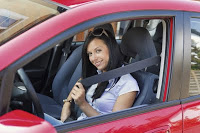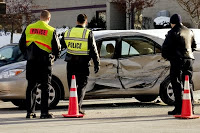Tag Archive: Teen drivers
This Driver’s Ed Program Gives Teens a Heart-Pounding Experience
August 21, 2006
You think you know it all when it comes to being behind the wheel of a car. However, after a lesson or two with this new driver’s education program for teens, you will figure out that maybe you didn’t know so much after all. The kicker is that teenagers, after some heart pounding moments, are enthusiastic about this program called Driver’s Edge.
It was started by a former race care driver named Jeff Payne. He mentions the fact that teens could ace Driver’s Ed but still have no clue how to handle a car during stressful times. With Driver’s Edge, teenagers are put through their paces, experiencing difficult driving situations. What do you do when your car goes into a skid? Many teenagers don’t really know and will overcompensate, sometimes causing an accident on the road.
Driver’s Edge will help you anticipate your moves in stressful situations. They will teach you how to carefully execute out of a skid. You will learn anti-lock braking and techniques on panic braking. Evasive lane-changing maneuvers are also on the agenda. It all sounds too cool doesn’t it, sort of like a James Bond or Fast and the Furious kind of thing. But it is real life and it will likely get your adrenaline pumping a bit.
While you would be behind the wheel of the car, a former race car driver and licensed instructor is beside you the entire time. Their job is to ensure that you don’t panic when faced with different stressful driving scenarios. They want you to act instinctively without over thinking it. Trial by fire in a controlled setting is the best way for teens to learn how to handle themselves behind the wheel of a car and avoid accidents. And we all know how the parents are going to get if that happens!
Read more driver education news in the Safe Driving Teen Monthly Bulletin. Each month the National Safety Commission publishes the bulletin for teens and parents designed to improve teen driver behavior, attitude, skills, and experience. Subscription Details

Unbelted Teen Killed in Crash
August 3, 2006
Missouri teen Charles “Charlie” J. Glik, 16, was driving at about 3 a.m. when his car left the roadway and struck a utility pole, police said. The impact snapped the pole in half, and Charlie, who was not wearing his seat belt, died at the scene..
Source: stltoday.com
Safe Driving Lesson Learned
In 28 of the states with belt use laws in 2004, the law specified secondary enforcement. That is, police officers are permitted to write a citation only after a vehicle is stopped for some other traffic infraction.
As of December 2004, 49 states and the District of Columbia had belt use laws in effect. The laws differ from state to state, according to the type and age of the vehicle, occupant seating position, etc.
Research has found that lap/shoulder safety belts, when used, reduce the risk of fatal injury to frontseat passenger car occupants by 45 percent and the risk of moderate-to-critical injury by 50 percent. For light truck occupants, safety belts reduce the risk of fatal injury by 60 percent and moderate-tocritical injury by 65 percent.
Among passenger vehicle occupants over 4 years old, safety belts saved an estimated 15,434 lives in 2004.
Wear your safety belt and shoulder harness properly. In a crash, you are far more likely to be killed if you are not wearing a safety belt. Wearing shoulder belts and lap belts make your chances of living through a crash twice as good.
Airbags, combined with lap/shoulder safety belts, offer the most effective safety protection available today for passenger vehicle occupants. Research indicates an overall fatality-reducing effectiveness for airbags of 11 percent when a safety belt is used in conjunction with the airbag. In 2004, an estimated 2,647 lives were saved by airbags.
This post is an excerpt from a recent edition of the Safe Driving Teen Monthly Bulletin. Each month the National Safety Commission publishes the bulletin for teens and parents designed to improve teen driver behavior, attitude, skills, and experience. Subscription Details

Teenagers Involved in One Third of Fatal Automobile Crashes
July 24, 2006
About one third of the people killed in automobile crashes involving the nation’s youngest drivers were pedestrians or occupants of other vehicles, according to a recent report. An analysis of federal crash statistics by the AAA Foundation for Traffic Safety found that nearly 31,000 people were killed in crashes involving drivers between the ages of 15 and 17 between 1995 and 2004. The foundation said it was surprised to learn that one-third of those deaths involved pedestrians and people in other vehicles.
Source: SeattleTimes.nwsource.com
Safe Driving Lesson Learned
According to the National Highway Traffic Safety Administration, on the basis of miles driven, teenagers are involved in three times as many fatal crashes as are all drivers. Why do young drivers have such poor driving performance?
Three factors work together to make the teen years so deadly for young drivers:
- Inexperience
- Risk-taking behavior and immaturity
- Greater risk exposure
With graduated driver licensing, new drivers typically go through a three-stage process that involves their gradual introduction to full driving privileges. By restricting when teenagers may drive, and with whom, graduated driver licensing allows new drivers to gain much-needed on-the-road experience in controlled, lower-risk settings. It also means that a teenager will be a little older and more mature when he or she gains a full, unrestricted license. After the young driver demonstrates responsible driving behavior, restrictions are systematically lifted until the driver “graduates” to full driving privileges.
This post is an excerpt from a recent edition of the Safe Driving Teen Monthly Bulletin. Each month the National Safety Commission publishes the bulletin for teens and parents designed to improve teen driver behavior, attitude, skills, and experience. Subscription Details

Reducing Driving Hours Saves Teen Lives
July 20, 2006
Canada’s Traffic Injury Research Foundation announced that by limiting a teenage driver’s time behind the wheel of a car, and reducing the number of people in his or her vehicle, accident rates among teen drivers can be reduced by 20 percent.
Researchers compared 2002 crash data amongst 16-year-old drivers in both Oregon and Ontario, Canada. Oregon has restrictions on unsupervised driving at night, while Ontario did not have any restrictions at that time.
Accidents among 16-year-old drivers who were at the wheel of a vehicle where injuries and fatalities occurred were 20 percent fewer in Oregon than Ontario, giving strong evidence that Graduated Drivers Licensing programs (GDL) can make a big difference.
Auto accidents are the leading cause of death among young people, killing around 6,000 drivers between the ages of 16 and 20. According to safety authorities, the lack of driving skills and experience make teenage drivers more prone to accidents.
“Teens who obey traffic rules and regulations, follow GDL regulations, and have actively involved parents are much less likely to crash,” commented J. Peter Kissinger, president and CEO of the AAA Foundation for Traffic Safety, which sponsored the study.
Licensing laws that put restrictions on young drivers vary from state to state, and some are less demanding than others, as was the case in Oregon, with stronger GDL laws than Ontario.
Oregon prevents unsupervised driving by new drivers between midnight and 5 a.m. and prohibits passengers under age 20 from being in a car driven by an entry-level driver during the first six months of receiving a driver’s license.
According to Dan Mayhew, vice president of the Traffic Injury Research Foundation, the findings, based on law enforcement accident data, imply that “the restrictions placed in Oregon are effective in keeping the crash rates down.”
Another separate phone study conducted with 1,000 teenage drivers in Oregon and British Columbia found that 30 percent of teens that had not been involved in an accident also ever violated the passenger rules during the first six months of their intermediary stage.
Sixteen percent of young people who had accidents also said they had not violated the restrictions during the same period.
The findings show that teens that were involved in accidents were more inclined to break driving laws. In Oregon, 33 percent of teenagers who were involved in accidents admitted to receiving a traffic ticket, compared to 13 percent of teens that received tickets but had not crashed.
Mayhew commented that the GDL laws are “not a panacea” but work as an effective tool in reducing crashes among beginning drivers.
The National Safety Commission and Lowest Price Traffic School offer safe teen driving resources for new drivers and their parents. Find out more about our monthly newsletter for teen drivers and the Driver Education Guide for Parents.

Seriously, Wear a seat belt!
July 20, 2006
Investigators in Clark County, Ohio said 18-year-old Jacob Beam of Fairborn was killed in an accident on the morning of Sunday, June 11. Investigators said it appears the driver may have lost control, went off the road and struck a utility pole; neither teen was wearing a seat belt.
Source: WHIOTV.com
Safe Driving Lesson Learned
Wear lap belts around your hips, not your stomach. Fasten them snugly. Wear a shoulder belt only with a lap belt. Don’t just use your safety belt for long trips or high-speed highways. More than half of the collisions that cause injury or death happen at speeds less than 40 mph, and within 5 miles of home.
Some people think that because their car is equipped with an airbag they don’t have to wear their safety belt. Airbags will save your life, sometimes in a head-on collision. But you still have to wear your safety belt with an airbag. Excuses some people make for not wearing a safety belt:
- It wrinkles my clothes. All you need to do is take a handkerchief or a small hand towel and keep it in your car. If you’re wearing nice clothes, put the handkerchief or towel between the seat belt and your clothes. It smoothes out that area and keeps it wrinkle free.
- They’re uncomfortable. If your safety belt touches your neck and it’s uncomfortable, purchase a sheepskin or cloth covering. You put the covering over the spot on the seat belt that irritates you. This makes wearing the seatbelt more comfortable. You could also have a mechanic lower the belt an inch or two for a few dollars.
- I forgot. If you make fastening your safety belt a habit, you will never forget.
- They’re broken. Get them fixed – it could save your life!
- I can brace myself in a crash. You cannot brace yourself. A 30-mph crash is the same force of impact as falling off a four-story building. Imagine that you are on the fourth floor of a building where there’s a balcony. Could you dive off the balcony and land on the sidewalk in the pushup position? You couldn’t – it is impossible.
This post is an excerpt from a recent edition of the Safe Driving Teen Monthly Bulletin. Each month the National Safety Commission publishes the bulletin for teens and parents designed to improve teen driver behavior, attitude, skills, and experience. Subscription Details
